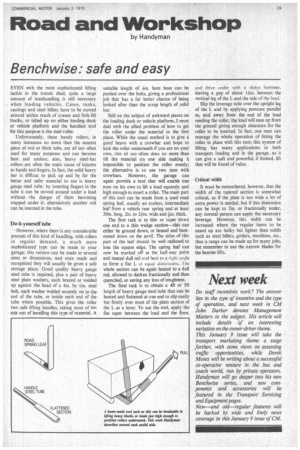Road and Workshop
Page 31

If you've noticed an error in this article please click here to report it so we can fix it.
by Handyman
Benchwise: safe and easy
EVEN with the most sophisticated lifting tackle in the transit shed, quite a large amount of manhandling is still necessary when loading vehicles. Cases, tanks, castings and steel billets have to be moved around within reach of cranes and fork-lift trucks, or tidied up on either loading dock or vehicle platform and the handiest tool for this purpose is the steel roller.
Unfortunately, these handy rollers, in many instances no more than the nearest piece of rod or thick tube, are all too often used for many purposes and can become bent and useless; also, heavy steel-bar rollers are often the main cause of injuries to hands and fingers. In fact, the solid heavy bar is difficut to pick up and by far the better and safer material to use is heavy gauge steel tube: by inserting fingers in the tube it can be moved around under a load without the danger of them becoming trapped under it; alternatively another rod can be inserted in the tube.
Do-it-yourself tube • However, where there is any considerable amount of this kind of handling, with rollers in regular demand, a much more sophisticated type can be made in your garage; this version can be made in several sizes or dimensions, and once made and recognized they will usually be given a safe storage place. Good quality heavy gauge steel tube is required, plus a pair of heavy steel plain washers, each brazed or welded up against the head of a 4in. by 4-in. steel bolt, each washer welded securely on to the end of the tube, or inside each end of the tube where possible. This gives the roller two safe lifting handles, taking most of the risk out of handling this type of material A suitable length of i.in. bore hose can be pushed over the bolts, giving a professional job that has a far better chance of being looked after than the scrap length of solid bar.
Still on the subject of awkward pieces on the loading dock or vehicle platform, I must deal with the allied problem of how to get the roller under the material in the first place. While the usual method is to give a good heave with a crowbar and hope to kick the roller underneath if you are on your own, this all too often does no more than tilt the material on one side making it impossible to position the roller evenly; the alternative is to use two men with crowbars. However, the garage can again provide a tool that will enable 'one man on his own to lift a load squarely and high enough to insert a roller. The main part of this tool can be made from a used road spring leaf, usually an eyeless, intermediate leaf from a vehicle rear spring and at least 30in. long, 21n. to 24-in wide and bin. thick.
The first task is to thin or taper down one end to a thin wedge section—this can either be ground down, or heated and hammered down on the anvil The sides of this part of the leaf should be well radiused to lose the square edge. The spring leaf can now be marked off at the half-way point and heated dull rid and bent to a right angle to form a flat L oi equal dimensions. l he whole section can be again heated to a dull red, allowed to darken fractionally and then quenched, so saving any loss of toughness.
The final task is to obtain a 4ft or 5ft length of heavy gauge steel tube that can be heated and flattened at one end to slip easily but firmly over most of the plain section of the L as a lever. To use the tool, apply the flat taper between the load and the floor,
and drive under with a sledge hammer.
leaving a gap of about between the vertical leg of the L and the side of the load.
Slip the leverage tube over the upright leg of the L and by applying pressure parallel to, and away from the end of the load needing the roller;the load will ease up from the ground giving enough clearance for the roller to be inserted. In fact, one man can manage the whole operation of fitting the roller in place with this tool; this system of lifting has many applications in both transport loading and in the garage, as it can give a safe and powerful, if limited, lift that will be found of value.
Critical width It must be remembered, however, that the width of the tapered section is somewhat critical, as if the plate is too wide a lot of extra power is needed, but if this dimension can be kept to 2in. or fractionally under, any normal person can apply the necessary leverage. However, this width can be increased where the regular items to be eased up are bulky but tighter than solids such as steel billets, girders, machines, etc., thus a range can be made up for many jobs, but remember to use the narrow blades for the heavier lifts.




















































































